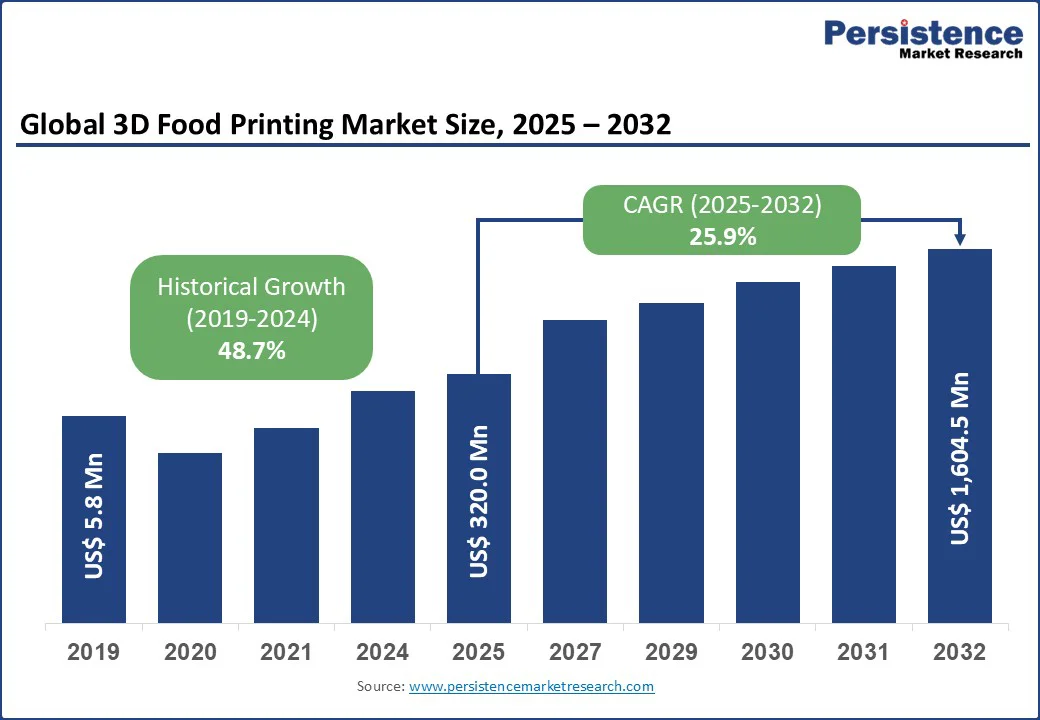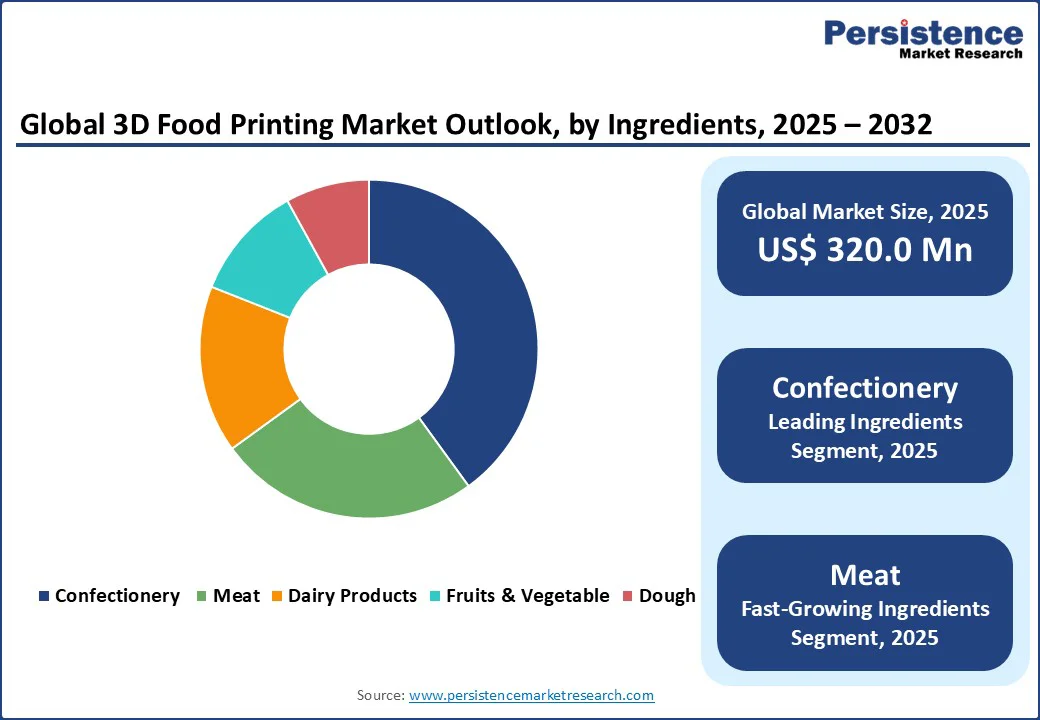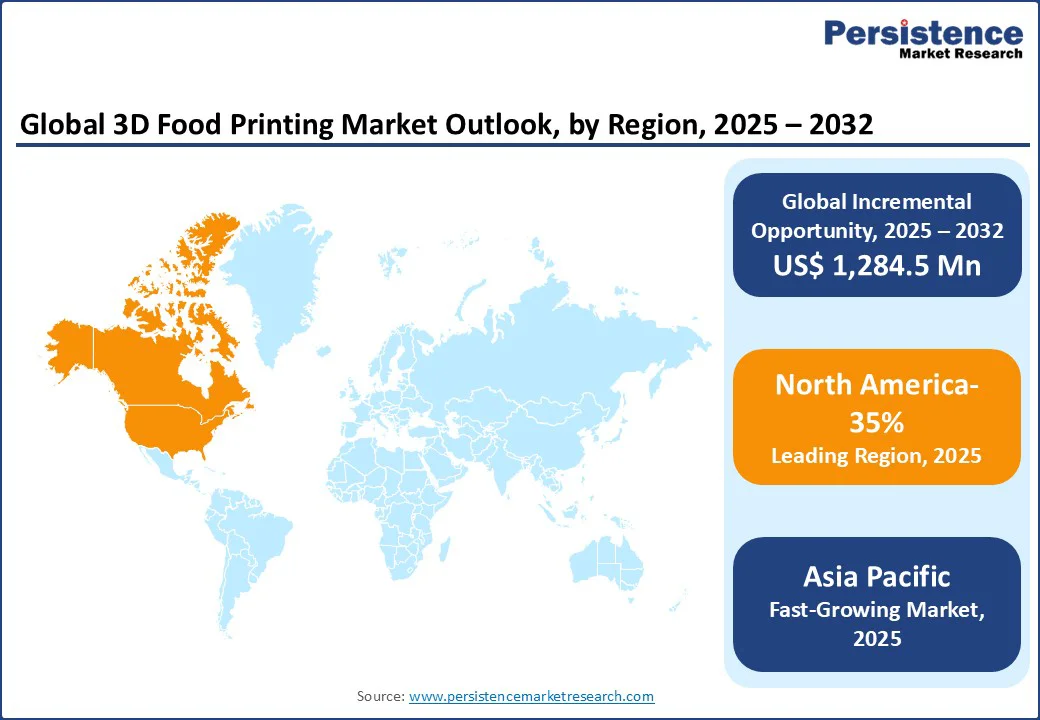ID: PMRREP11176| 190 Pages | 23 Sep 2025 | Format: PDF, Excel, PPT* | Food and Beverages

The global 3D food printing market size is likely to be valued at US$320.0 million in 2025 and is expected to reach US$1,604.5 million by 2032, growing at a CAGR of 25.9% during the forecast period from 2025 to 2032.
Rising demand for personalized and eco-friendly food solutions. Cutting-edge 3D printing technology enables customized shapes, textures, and nutritional content, catering to health-conscious consumers.
Key Industry Highlights:

| Global Market Attribute | Key Insights |
|---|---|
| 3D Food Printing Market Size (2025E) | US$320.0 Bn |
| Market Value Forecast (2032F) | US$1,604.5 Bn |
| Projected Growth (CAGR 2025 to 2032) | 25.9% |
| Historical Market Growth (CAGR 2019 to 2024) | 48.7% |
The growing focus on personalized nutrition and sustainable food production is becoming a major driver in the global food industry. Personalized nutrition is gaining traction as consumers seek diets tailored to their genetics, health conditions, and lifestyle.
With the rising prevalence of chronic diseases such as diabetes and obesity, the demand for nutrient-specific diets, functional foods, and AI-driven health solutions is accelerating. Advances in nutrigenomics and digital health tools further support this shift, enabling individuals to track and optimize their nutritional intake more effectively.
At the same time, sustainable food production is crucial for addressing climate change and alleviating resource pressures. Governments are implementing strong measures to support eco-friendly farming practices.
For instance, India has expanded its National Mission on Natural Farming and introduced the PM-PRANAM scheme, which encourages the reduced use of chemical fertilizers and the greater adoption of organic inputs. Such initiatives illustrate how public policy and consumer demand are converging to promote healthier diets and environmentally responsible food systems.
One of the key restraints for the industry is the high cost of adoption, which limits large-scale implementation. Developing advanced solutions in areas such as personalized nutrition or sustainable food production often involves significant investment in research, infrastructure, and specialized technologies.
These costs make products and services more expensive, restricting accessibility for a wider consumer base. For many companies, achieving economies of scale remains challenging, particularly in emerging markets where price sensitivity is high.
In addition, technical limitations pose a barrier to growth. Personalized nutrition, for example, requires accurate genomic data, advanced analytics, and reliable digital tools, all of which are still evolving. Similarly, sustainable farming technologies face issues such as inconsistent yields and scalability challenges. These constraints slow adoption rates and limit the pace of industry transformation.
The industry presents significant opportunities through its expansion into healthcare and space exploration. In healthcare, personalized nutrition and sustainable food solutions are being integrated into preventive care, chronic disease management, and wellness programs.
Hospitals and clinics are increasingly adopting personalized dietary solutions to enhance patient recovery and improve long-term health outcomes. The growing use of nutrigenomics and AI-driven nutrition platforms also opens pathways for collaboration between food companies, healthcare providers, and biotech firms, creating a multi-disciplinary growth opportunity.
In space exploration, ensuring reliable and nutritious food systems is a critical priority for long-duration missions. Research on bioengineered foods, hydroponics, and lab-grown proteins offers the potential to sustain astronauts in space while advancing innovations that can also be applied on Earth. This dual-use development positions the industry at the intersection of technological advancement, healthcare innovation, and future-ready food production.
In 2025, extrusion-based printing leads the 3D food printing market with a commanding 60% share. Its widespread adoption is attributed to low operational costs, flexibility, and compatibility with a variety of ingredients. The technology is well-suited for producing complex geometries, layered textures, and bulk food items, making it highly favored for bakery products, chocolates, and customized meal solutions. Its scalability and reliability continue to reinforce its dominance in both commercial and experimental use.
On the other hand, inkjet printing is witnessing the fastest growth, driven by its accuracy and ability to deliver intricate, high-resolution designs using edible inks. This method is increasingly utilized for decorating cakes, pastries, and beverages, where visual creativity is a strong consumer demand. With its potential for digital customization and aesthetic innovation, inkjet printing is poised to be a key growth engine in the food printing sector.
In 2025, the confectionery segment holds the largest share of the 3D food printing market, accounting for nearly 40%. Its dominance is driven by strong consumer demand for visually appealing and customizable chocolates, candies, and desserts. Extrusion and inkjet-based printing technologies are widely adopted in this segment, enabling intricate designs, unique textures, and personalized offerings that enhance product value and appeal. The rising popularity of premium confectionery and gifting products further supports its leading market position.
Conversely, the meat segment is emerging as the fastest-growing category. The rapid expansion is fueled by advancements in cultured and plant-based meat printing, addressing consumer demand for sustainable, protein-rich alternatives. Growing investments in alternative proteins and supportive government initiatives are accelerating adoption, positioning meat printing as a transformative solution in the future of food production.
In 2025, the commercial segment leads the 3D food printing market, accounting for a 50% share, reflecting its extensive use across restaurants, bakeries, catering services, and food manufacturers. The ability to create personalized meals, attractive designs, and produce on a large scale makes it highly attractive for businesses aiming to enhance customer experience and streamline operations. Growing adoption in the hospitality industry, coupled with rising demand for customized and premium food offerings, continues to drive this segment’s dominance.
At the same time, the government segment is projected to be the fastest-growing. Increasing interest in food security, sustainable production, and nutrition-focused initiatives is encouraging governments to explore 3D printing technologies for public programs, disaster relief, and defense applications. By supporting innovation and investing in pilot projects, government initiatives are expected to accelerate the integration of 3D food printing into large-scale, socially driven applications.

In 2025, North America leads the 3D food printing market with a 35% share, supported by advanced technological infrastructure, strong consumer demand, and widespread adoption across commercial and institutional sectors. The region’s dominance is reinforced by significant R&D spending, a mature food processing ecosystem, and the active presence of leading industry players driving product innovation.
Rising interest in personalized nutrition, premium confectionery, and plant-based food alternatives continues to accelerate growth. Furthermore, supportive government initiatives promoting food sustainability and the expanding use of 3D food printing in healthcare, defense, and space programs further solidify North America’s leading market position.
In 2025, Europe is expected to hold a significant share of the 3D food printing market, driven by strong technological adoption, a mature food and beverage sector, and high consumer demand for sustainable and customized food products. The region benefits from widespread acceptance of advanced food technologies, coupled with stringent regulations that promote food safety and sustainability.
The growing interest in plant-based proteins, gourmet confectionery, and nutritionally balanced meals is further driving adoption across both commercial and institutional sectors. Additionally, active investments in research, along with government-backed initiatives focused on food innovation and environmental responsibility, reinforce Europe’s position as a key market for 3D food printing.
The Asia Pacific region is emerging as the fastest-growing market for 3D food printing, driven by rapid urbanization, rising disposable incomes, and increasing consumer interest in personalized and sustainable food solutions. Countries such as China, Japan, and South Korea are witnessing accelerated adoption due to technological advancements, the growth of the foodservice industry, and supportive government initiatives that promote innovation in food production.
The expanding demand for plant-based proteins, functional foods, and customized confectionery products further fuels growth. Additionally, investments in R&D and collaborations between technology providers and food manufacturers are helping the region overcome technical barriers, positioning the Asia Pacific as a key growth hub in the global market.

The global 3D food printing market is highly dynamic, driven by continuous innovation and strategic collaborations between technology providers, food manufacturers, and research organizations. Market players are focusing on enhancing printing technologies, expanding product offerings, and improving customization to meet rising consumer demand for personalized and sustainable food solutions.
Investments in R&D, strategic partnerships, and mergers are accelerating advancements in material versatility, efficiency, and scalability. Innovation, technological leadership, and early adoption remain critical factors defining competitiveness in the growing market.
The 3D food printing market is projected to reach US$320.0 mn in 2025, driven by personalized nutrition and sustainable food production.
Rising demand for customized food, advancements in printing technology, and sustainability initiatives fuel market growth.
The 3D food printing market will grow from US$320.0 mn in 2025 to US$1,604.5 mn by 2032, with a CAGR of 25.9%.
Expansion in healthcare, space exploration, and emerging markets drives opportunities for innovative food solutions.
Leading players include Systems And Materials Research Corporation, Choc Edge, 3D Systems, Inc., Procusini, Revo Foods, Mucusini, FELIXprinters, Savoureat Ltd, 3D Food Srl, Redefine Meat Ltd., and Changxing Shiyin Technology Co., Ltd..
| Report Attribute | Details |
|---|---|
| Historical Data/Actuals | 2019 - 2024 |
| Forecast Period | 2025 - 2032 |
| Market Analysis | Value: US$ Bn, Volume: As Applicable |
| Geographical Coverage |
|
| Segmental Coverage |
|
| Competitive Analysis |
|
| Report Highlights |
|
By Technology
By Ingredient Type
By End-use
By Region
Delivery Timelines
For more information on this report and its delivery timelines please get in touch with our sales team.
About Author